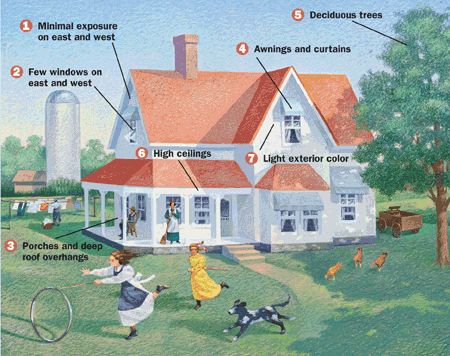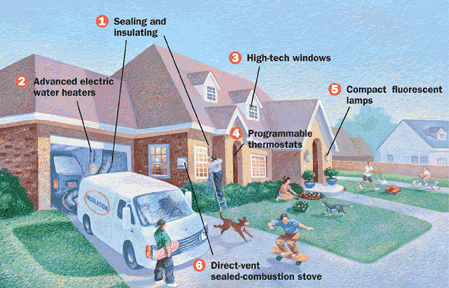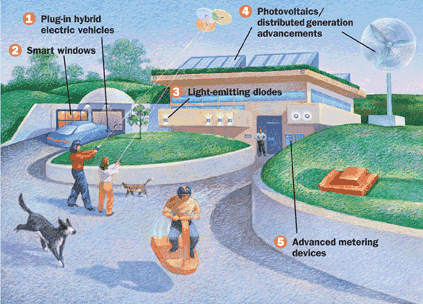Home improvement investments that reduce utility bills are more important than ever. With both the cost of energy and environmental concerns rising, it’s pretty clear that the age of excess is over. And electric cooperative members everywhere are becoming smarter energy users.The aim of this month’s cover story is to provide a brief overview of projects, designs and products for increasing home efficiency and comfort. We’ll look at old and new ideas as well as some emerging technologies that could come to market in the near future.
Some investments pay off better than others. It may not be cost-effective to spend the money for expensive window replacements, for instance, when many other improvements can be made more affordably and have a bigger impact on your bottom-line energy use and home’s comfort.
The first step in deciding what makes sense for you is to get an energy audit or learn to perform one yourself. Many electric co-ops do energy audits or will guide you to local professionals who do them. Audits vary in scope, but their primary intent is to identify your problems and come up with solutions. Often, some of the greatest savings involve relatively low-cost repairs. This especially is the case with older homes. For expenditures of $2,000 or less on weatherization, some households can save more than $1,000 annually on electricity costs, experts say.
 Before beginning any improvement project, check with your co-op, local conservation officials and state energy office. They can provide advice on local contractors and suppliers and information on incentives and rebates available in your area.
Before beginning any improvement project, check with your co-op, local conservation officials and state energy office. They can provide advice on local contractors and suppliers and information on incentives and rebates available in your area.
Some things old
Your grandparents and great-grandparents knew what they were doing.
The design and orientation of their homes was crucial in creating a comfortable living space before the advent of centralized heating and cooling. Thanks to the current trend in green building, attention has again been placed on these time-tested methods.
Homes designed around the conditions in which they are built not only use less energy, but also are more comfortable.
Consider some basic principles of design and orientation from the following examples:
- Homes designed for warmer regions emphasize shading and passive ventilation. They are long and narrow, minimizing exposures from the east and west where the sun is most direct. Homes designed for colder regions work to passively collect and preserve heat. They are traditionally more compact in shape to minimize exterior surface area, retain heat and reduce overall heating needs.
- Windows are minimal on these sides for the same reason.
- Porches and deep roof overhangs offer protection against the harsh summer sun.
- Awnings shade windows and walls in warm climates. To passively capture heat in cold climates, windows are placed on the south side. Awnings are removed in cold weather.
- Deciduous trees shade the east and west walls in warm climates. In winter, when trees lose their leaves, the house benefits from the sun’s warmth. In cold climates, evergreen trees are planted as a windbreak on the north/northwest side.
- Higher ceilings allow heat to rise above occupants in warm climates. In cold climates, ceilings are lower to keep heat where it is needed.
- Light exterior colors reflect the sun’s heat. Dark exterior colors absorb the sun’s heat.
Some things new
- Sealing and insulating are not exactly new, but they remain the most important step in improving a home’s efficiency. Use weatherstripping around windows and doors and caulks and spray foams around window frames, pipes, fixtures and other gaps.
 Attic floor insulation is typically the most cost-effective investment whether you do it yourself or hire someone to do it for you. Don’t forget to seal and insulate ductwork as well. For the benefit of your health, consider using sealants that are low in volatile organic compounds (VOCs) and a form of formaldehyde-free insulation. VOCs are emitted as gases from certain solids or liquids and include a variety of chemicals, some of which may have short- and long-term adverse health effects.
Attic floor insulation is typically the most cost-effective investment whether you do it yourself or hire someone to do it for you. Don’t forget to seal and insulate ductwork as well. For the benefit of your health, consider using sealants that are low in volatile organic compounds (VOCs) and a form of formaldehyde-free insulation. VOCs are emitted as gases from certain solids or liquids and include a variety of chemicals, some of which may have short- and long-term adverse health effects. - Advanced electric water heaters have energy factors of 92 percent and above. They are super-insulated with foam to prevent heat loss. Some, like the Marathon, have life-time warranties. Also, installing tubular foam insulation around all accessible hot water pipes, especially immediately above the tank, reduces heat loss and can raise water temperature 2-4 degrees F above what uninsulated pipes can deliver, allowing for a lower water temperature setting. You also won’t have to wait as long for hot water when you turn on a faucet or showerhead, which helps conserve water. It’s also a good idea to insulate the cold water inlet pipes for the first 3 feet.
- High-tech double- and triple-pane windows with low-emissivity (low-E) coatings — virtually invisible layers of metal or metallic oxide that reduce the amount of heat that passes through the glass — are vastly more efficient than single-pane windows. For this reason, replacing windows is often a top choice when considering major renovations. Such windows are very expensive and should be much lower on your priority list than good old caulking and insulation. For a low-cost alternative, apply a low-E film to existing windows. It is effective both in reflecting unwanted heat in summer and in retaining heat in winter and is widely available as a do-it-yourself kit. Solar screens are still another choice and particularly appropriate for large, scenic windows. Exterior applications are far more effective in blocking heat.
- Programmable thermostats offer one of the easiest and most affordable ways to save energy at home. They can save almost $200 per year by reducing household heating and cooling at times when it’s not needed.
- Compact fluorescent lamps (CFLs) are profoundly more efficient than traditional incandescent lightbulbs, which waste up to 90 percent of the electricity they consume in creating heat. An estimated $25 to $45 can be saved per CFL over its lifetime. The newest generation of CFLs is finally coming of age and even includes dimmable bulbs. Stick with 2,700 K (Kelvin) lights — Kelvin, a unit increment of temperature, measures the color temperature of light sources — for interiors to best match the warmth of incandescent bulbs.
- Advanced direct-vent, sealed-combustion stoves have revolutionized fireplaces in homes. Unlike conventional fireplaces, which can actually lose more energy than they generate by drawing interior air up the chimney, this new breed of stoves reaches about 90 percent efficiency. Since the stoves are vented directly to the outside through a hole in an exterior wall, there is no need to construct a chimney or run a freestanding flue above the roofline. These stoves are available as inserts for existing fireplaces and can be fueled by gas, wood or pellets.
Some things future
- Plug-in hybrid electric vehicles — The next generation of electric hybrids coming down the pike will offer higher fuel efficiency and range. These plug-in electric/gas powered vehicles will travel up to 150 miles on a gallon of gasoline.
 General Motors says its just a model year away from launching the Chevy Volt, an extended-range electric vehicle designed to move more than 75 percent of America’s daily commuters, who drive less than 40 miles a day, using zero gasoline and producing zero tailpipe emissions.
General Motors says its just a model year away from launching the Chevy Volt, an extended-range electric vehicle designed to move more than 75 percent of America’s daily commuters, who drive less than 40 miles a day, using zero gasoline and producing zero tailpipe emissions. - Smart windows work a lot like those funny eyeglasses that tint in the sun and then change back to clear indoors. In the case of electrochromic windows — electronically tintable glass that can be switched from clear to darkly tinted, and vice versa — the glass responds to an electrical current that can be controlled by a switch, light sensors, thermostats or even a motion sensor. New designs — including ones that use integrated solar cells to produce power — promise greater efficiency. Thermo reflective windows are activated only by heat, and, according to the manufacturer, they are superior in stopping heat from entering a building. Because they respond only to heat, the windows let in more heat (and light) in cold weather and block it in warm weather. The manufacturer uses a similar approach toward managing heat with an advanced thermo reflective wall or cladding technology that can be “programmed” at the time of manufacture to reflect heat at a specific temperature.
- Light-Emitting Diodes (LEDs) — Home applications of LEDs now are found mainly in flashlights and task lights. With a lifespan of approximately 60,000 hours — as compared to CFLs’ 10,000 hours and incandescent bulbs’ 1,500 hours — LEDs are a product with a great future. The market is waiting for costs to decrease.
- Thin-film solar photovoltaics (PVs), like conventional PVs, convert sunlight into electricity. They improve on conventional PVs by being lightweight, flexible and, most importantly, far cheaper to produce. Expect to see a variety of home-related products from several manufacturers in the next two to three years. Many believe that the greatest advancements in future solar technology will involve the use of quantum dots — tiny semiconductors that use the unique light-harvesting properties of nano-sized crystals. The science is complicated, but the result is a theoretical doubling in efficiency (estimations are as high as 65 percent) for quantum-dot solar cells — as compared to today’s most efficient cells. Preliminary experiments suggest that quantum dot cells could be produced with relatively low material costs. Advancements in solar and wind turbine technology are expected to help make “distributed generation,” electricity generated at the point of use, much more prevalent and cost-effective in the next 20 years. The Electric Power Research Institute suggests distributed generation, if pursued aggressively, could supply as much as 5 percent of the nation’s baseload electric needs by 2030.
- Advanced metering devices — Many co-ops currently use digital metering to record electricity use and locate problems on lines. Some meters have two-way communication. In the future, such electronic communication tools will be more sophisticated so customers can determine when they use the most electricity and where they might reduce consumption. Time-of-day metering or rebates will probably be in effect to discourage electricity use during peak hours. Appliances will be programmable for use in non-peak hours.
Energy efficiency: the low-hanging fruit
Many folks hail energy efficiency as a “low-hanging fruit,” meaning it offers an easy way to make big changes in effectively managing electric bills.
But while new lightbulbs, appliances, and weatherization measures can make an existing home or commercial building more energy efficient and comfortable, bigger gains can be made to structures at the front end during design and construction. Building operations eat through 73 percent of all electricity generated by power plants in the United States every year, according to the U.S. Energy Information Administration.
Homeowners can join the trend and incorporate many of these ideas into both new and existing homes. LEED-certified homes benefit from lower energy and water bills.
Touchstone Energy® Cooperatives, the “brand ID” of the nation’s electric co-ops, has also adopted a set of efficiency standards for both new and existing homes. The Touchstone Energy Home Program, an initiative focused and implemented locally, assists cooperatives in working with members to ensure that residences meet nationally recognized energy efficiency criteria.
(For more information on the Indiana Touchstone Energy Home Program, contact your co-op or visit: http://www.itehome.com/index.asp.)
The timing is right for homeowners looking to make such changes. The massive federal economic stimulus package signed into law last winter provides a homeowner efficiency tax credit of up to $1,500, or 30 percent, of the cost for weatherization upgrades, including insulation that meets the 2009 International Energy Conservation Code — more low-hanging fruit.
For more information on integrating energy efficiency features in your home or business, as well as taking advantage of related tax credits, contact your local electric co-op or visit www.energystar.gov.
Other online resources
Home energy savings information and tips
• www.energy.gov/yourhome.htm
• http://ase.org
• http://www.eeba.org
Home energy audit calculators
• www.energyguide.com/audit/haintro.asp
Touchstone Energy tips and information
This month’s featured story package was written for the nation’s electric cooperative consumer publications by Jody Horton, an Austin, Texas-based freelancer specializing in the study of green building. Some material was added by Electric Consumer, Texas Co-op Power and NRECA.



